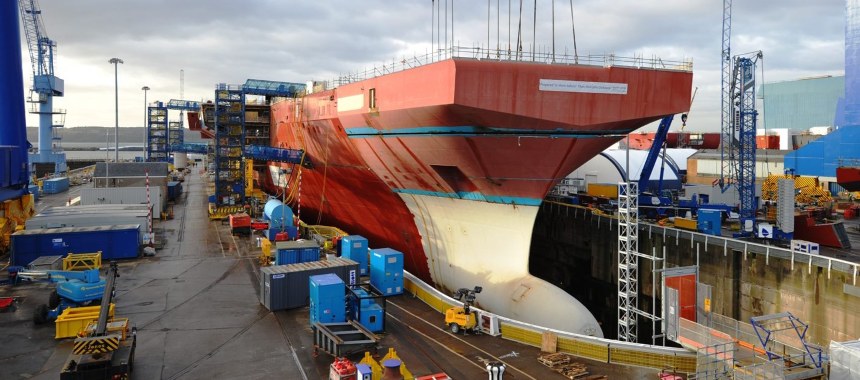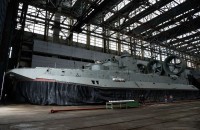The newest aircraft carrier HMS Queen Elizabeth built

Five years later in the city of Rosite after cutting the first sheet of steel, the largest military ship of the Royal British Navy was named after Queen Elizabeth, who smashed a bottle of champagne on board the newest 65,000 ton aircraft carrier.
In the early 1990s, the Royal British Navy had three small aircraft carriers and a variety of anti-submarine frigates and destroyers, the main purpose of which was to destroy Soviet submarines in the North Atlantic. But the experience of the Falkland War proved the need for a fleet to support the expeditionary forces. In this way, in 2000, the United Kingdom Navy began a series of projects to improve its fleet in order to provide enhanced capabilities. This led to the replacement of numerous projects by their several larger counterparts, but with fewer personnel. The main examples were the replacement of destroyers of Project 42 for destroyers of Project 45. A similar situation has developed with submarines. At the moment, the system already has 4 of the 6 submarines of the newest Astute class. And very soon on July 4, 2014 the world will see the first of the long-awaited ships, a construction that began in May 2009.
This is the British aircraft carrier HMS Queen Elizabeth which will be launched on July 4, 2014. The ship is scheduled for commissioning only in 2017, after a very long running trial, which will begin in October 2016.
The hull of the second ship of the same type was also laid in May 2011. Both the aircraft carrier HMS Queen Elizabeth (R08) and HMS Prince of Wales (R09), after the transfer of the British Navy, will be the largest warships ever built for the Royal Navy. The estimated cost of the construction program is 6.2 billion pounds sterling. The full operational potential of the connection will be formed in 2020.
The decision to create two aircraft carriers of the Queen Elizabeth class for the British Navy was adopted on July 25, 2007. In this regard, for the restructuring of the naval shipbuilding industry, in just a year two corporations were merged — BAE Systems and VT Group in BVT Surface Fleet. Consider some of the characteristics of the newest aircraft carrier of the Royal Navy of Great Britain.
The aircraft carrier Queen Elizabeth is able to displace 70,600 tons of water at full load, has a length of 280 m, a width of 39 m, a draft of 11 m and a height of 70 m. The new aircraft carrier is equipped with a large flight deck with a springboard and two airplanes. On 9 hangar decks of an aircraft carrier with an area of 16 thousand square meters. m can be up to 50 aircraft such as F-35B Lightning II, Chinook, Augusta Westland Apache, Lynx Wildcat or Merlin Crowsnest AEW. Two aircraft lifters are used to supply aircraft and helicopters to the flight deck, each of which is capable of accommodating two aircraft.
A distinctive feature of this project is the presence of two superstructures of the island type — one for navigation and control of the ship, the second, which is closer to the stern, for the performance of flying operations. For defensive operations, the aircraft carrier is equipped with the Falancs system, machine guns and a 30 mm automatic gun.
The Ministry of Defense decided not to use nuclear installations on aircraft carriers of the Queen Elizabeth class because of their high cost.Therefore, the power plant for surface ships will be two gas turbine units Rolls-Royce Marine Trent MT30 with a total capacity of 48,000 hp, and four diesel generators generating the total amount of energy to 20 MW (27,000 hp), which are manufactured by Wartsila. All cars provide the ship with a speed of over 25 knots. The range of the aircraft carrier is 10 thousand nautical miles.
For the crew, the designers have provided a number of rooms for rest and hanging out. So on board there is a spacious gym, a cinema and four galley that can serve for one hour 960 dishes. Eleven medical personnel will closely monitor the health of all seafarers, flight and maintenance personnel. For this purpose, the medical unit is equipped with all necessary equipment, including an operating room and a dental office.
One of the no less important features of the British aircraft carrier will be the level of automation, which will significantly reduce the cost of operating the vessel, including a smaller number of crew. One such example is the ammunition supply system, which is organized in such a way that to the projectile for the entire delivery route, a person touches only once. Such work on these ships is usually carried out by two hundred sailors, and as a result of the above achievement, for the same operation on the aircraft carrier Queen Elizabeth only 32 people are required. Therefore, the number of crew is only 679 people, not counting 1,600 flight personnel. On the 12 decks of the aircraft carrier are placed 3000 rooms.
The creation of two ships involved more than 10 thousand people from 90 companies and enterprises, with 7 thousand of them at 6 shipyards across the UK building various parts of the aircraft carrier. Separate sections were delivered by tugs from different places to Rosait, where they assembled into a single structure.
 Installing the bow of the aircraft carrier
Installing the bow of the aircraft carrier
The first high-grade steel sheet for the aircraft carrier HMS Queen Elizabeth was cut in July 2009 at BAE Systems in Clyde, which marked the beginning of the construction of one of the ship's blocks. A little later at the end of 2009 at the Appledore enterprise in North Devon the construction of the nose of the aircraft carrier began. After their completion, the monoblocks were delivered to Rosait, where they were assembled into a single section.
- Comments
 en
en ru
ru uk
uk




